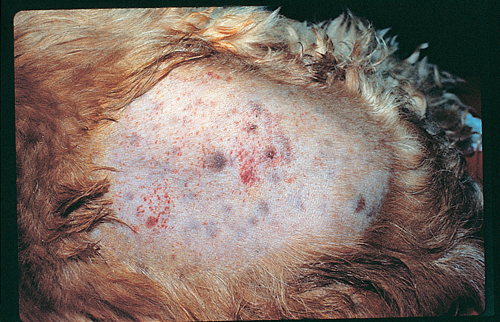Difference between revisions of "Small Animal Emergency and Critical Care Medicine Q&A 21"
Jump to navigation
Jump to search
| Line 13: | Line 13: | ||
<FlashCard questions="4"> | <FlashCard questions="4"> | ||
|q1=What abnormality is seen here? | |q1=What abnormality is seen here? | ||
| − | |a1= | + | |a1= |
Evidence of petechiae. | Evidence of petechiae. | ||
| − | |l1= | + | |l1=Platelet Abnormalities#Clinical Significance |
|q2=Abnormalitites of which part of the coagulation system will result in these clinical signs? | |q2=Abnormalitites of which part of the coagulation system will result in these clinical signs? | ||
|a2= | |a2= | ||
Revision as of 22:49, 10 October 2011
| This question was provided by Manson Publishing as part of the OVAL Project. See more Small Animal Emergency and Critical Care Medicine Q&A. |
This five-year-old, female Cocker Spaniel presented for evaluation of decreased appetite. PCV – 38%; TS – 6.8 gm/dl; ACT – 90 seconds; platelet count – 65,000/μl.
| Question | Answer | Article | |
| What abnormality is seen here? | Evidence of petechiae. |
Link to Article | |
| Abnormalitites of which part of the coagulation system will result in these clinical signs? | The presence of petechiae suggests the presence of either a vascular or platelet abnormality (vasculitis, thrombocytopenia, thrombopathia). |
Link to Article | |
| Is the platelet count low enough to result in clinical signs of spontaneous hemorrhage? | No. If the platelet count is less than 40,000/μl, the animal may have a bleeding tendency. Spontaneous hemorrhage, however, does not usually occur until the platelet count is less than 20,000/μl. |
Link to Article | |
| Name four categories for the etiology of the coagulation abnormality. List one example for each cause. | Causes of thrombocytopenia are:
|
[[Thrombocytopaenia |Link to Article]] | |
